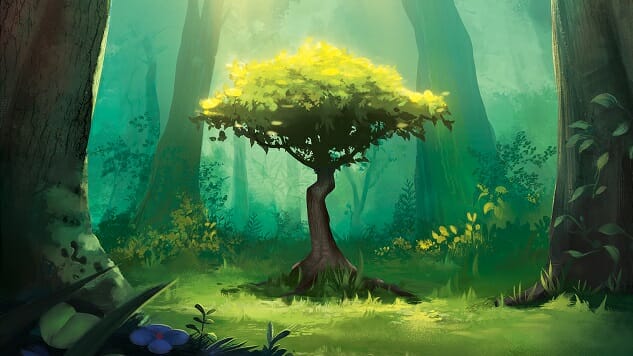The Elegant Photosynthesis Is a Board Game Treat

Blue Orange Games has had quite a year, with Kingdomino winning the 2017 Spiel des Jahres award for the family game of the year, its sequel Queendomino appearing this fall, and the release of Photosynthesis, my number three game of 2017 and one of the most visually arresting new titles this year. With a short rulebook of just four pages and a clever core mechanic that changes the values of spaces on the board each turn, it manages to take a real-world theme and work it into a simple, highly replayable game.
Photosynthesis is a game of happy little trees—you plant them, you grow them, and eventually you harvest them for victory points. The game’s currency is light, rather than money, and you collect light points each turn that you can expend to plant new seeds or grow trees you already have on the board. You collect light points based on the location of the sun, which rotates through six positions around the board through each game ‘year,’ and whether the spaces on which your trees sit have unimpeded access to the sun or are blocked by other trees—your opponents’ or even your own. The trees comprise two pieces of cardboard joined at a right angle, so they’re three-dimensional, and the sizes are different enough to distinguish at a glance. They come in four colors which sort of correspond to the four seasons, although in our plays, everyone wanted to use the blue conifers.
Each player gets a board with a light point counter and four columns of resources, one of seeds and three of trees in various sizes. At the start of the game, each player places two small trees in spaces at the outer edge of the board, and also begins with two seeds, three more small trees, and one medium tree in his/her supply; further resources must then be ‘purchased’ from the columns on the player’s board before they can be planted or grown. The board itself is hexagonal, so the cardboard sun piece moves around it to six fixed positions in each game-year, casting light on each of the seven columns of spaces on the board from a new angle on every turn. A tree receives light unless its space is in the shadow of a tree that stands between its space and the sun; a small tree casts a shadow of one space behind it, a medium tree casts a shadow of two spaces, and a large tree three spaces. Trees receive light points related to their size—one per turn for a small tree, two for a medium, three for a large, assuming they’re not in shadow.
-

-

-

-

-

-

-

-

-

-

-

-

-

-

-

-

-

-

-

-

-

-

-

-

-

-

-

-

-

-

-

-

-

-

-

-

-

-

-

-









































